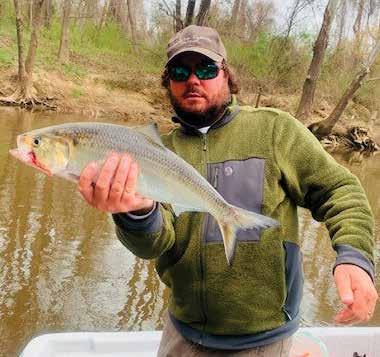
3 minute read
Cast a Line
THE
Advertisement
STORY AND PHOTOGRAPH BY CAPT. RICHARD ANDREWS
Hickory and American (locally called “White”) Shad are among the most fascinating fish species that occupy our estuaries and rivers. Their annual spawning migration into our Eastern North Carolina rivers such as the Tar,
Roanoke, Neuse, Cape Fear, and others is an amazing natural migration occurring from February through May which is deeply intertwined with American History, more modern Eastern NC culture, and most recently, a wider interest among anglers previously unfamiliar with the fishery. Shad fishing today is as popular as it’s ever been not only among locals who anxiously anticipate the first arrival of the fish in late January and early February but also conventional and fly fishermen from areas outside of shad alley looking for a sporty fish to catch on light tackle.
One of the best books I’ve ever read was written by John McPhee, a Princeton professor who wrote the modern day shad bible entitled, “The Founding Fish”. His work is a 370 page dissertation on the history, biology, geography, and fisheries surrounding these interesting creatures. The title came from a series of events occurring during the Revolutionary War when George Washington’s Army at Valley Forge was entrenched and on the brink on starvation on the banks of the Schuylkill River in Southern Pennsylvania during the winter and spring of 1778. Just as they were all about to starve to death, the annual shad migration arrived just in time for them to gorge themselves back to health and give them the strength to press onward, fight, and become victorious in their subsequent battles. Some argue that the result of the Revolutionary War would have been quite different if not for the shad.
To many “generational” sportsmen in Eastern North Carolina who hunt and fish throughout the year and whose lifestyle is mostly defined by those activities or hobbies, the shad migration is a much heralded event that comes just after the close of waterfowl season and provides them a direction during a time of year when nothing else is really happening. February and March are transitional months after hunting season closes and before most of the spring fishing begins as water temperature start to rise in April and May. Until recently, shad fishing in Eastern North Carolina has remained mostly a local activity attracting little attention from outside this area.
Most recently, the internet and social media have enabled anglers from all over the state and beyond to see the productive
Richard Andrews holds up an American shad he caught from Pamlico River.
shad fishery in Eastern North Carolina. Today in some of the shad hot spots such as the Tar River at Rocky Mount or the Roanoke River at Weldon, it’s common to see anglers from all over fishing from a boat or from the banks for these hardfighting foes. I’ve conversed with a few dedicated shad anglers at these areas who have traveled great distances to experience our fishery, some of whom travel all over the country to fish the various shad migrations occurring on the eastern seaboard from the St. John’s River in Florida to Newfoundland. Among the many shad migrations on the east and west coasts of the US, eastern North Carolina has some of the best for both hickory and American Shad. I encourage you to explore this unique fishery in Eastern North Carolina. I’m confident that you’ll enjoy catching these unique fish just a few miles upstream in any of our major rivers. For more information on shad fishing in Eastern North Carolina, visit my website at www.tarpamguide. com or reach out via email at richard@tarpamguide.com.
Capt. Richard Andrews is a resident of Washington and the owner of a local year-round guide service offering fishing excursions on the Pamlico and nearby rivers. He can be reached at 252-945-9715 or richard@tarpamguide.com.⋇












